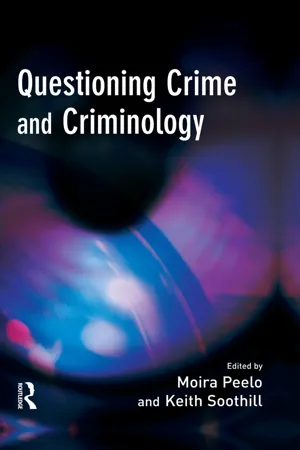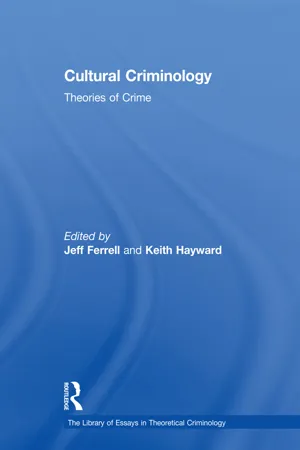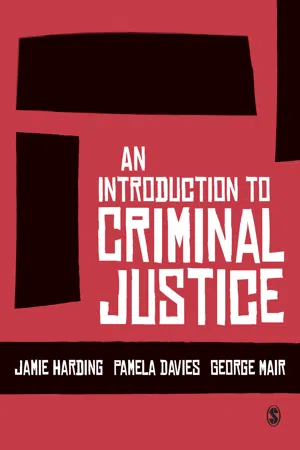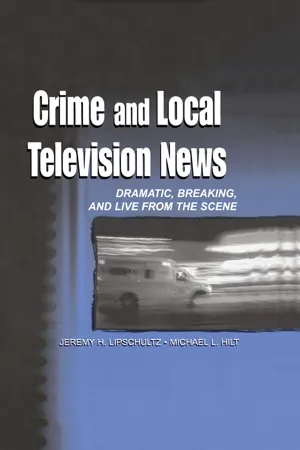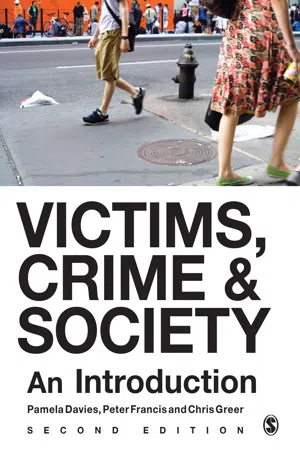Social Sciences
Media and Crime
Media and crime refer to the relationship between mass media and the portrayal, reporting, and representation of criminal activities and justice system processes. This includes the influence of media on public perceptions of crime, the criminal justice system, and the impact of media coverage on crime rates and public policy. The media's role in shaping public attitudes and responses to crime is a key focus of study in this area.
Written by Perlego with AI-assistance
Related key terms
8 Key excerpts on "Media and Crime"
- eBook - ePub
- Tim Newburn(Author)
- 2017(Publication Date)
- Routledge(Publisher)
The media are – and arguably always have been – a source of many of our contemporary fears. Greer and Reiner (2012) identify two main public anxieties about the media: first that they are in some way subversive and, alternatively, that they are a more or less subtle form of social control. In the former, the media are perceived as a source of criminality; in the latter, a source of misrepresentation and exaggeration. Both positions rest on the assumption that the mass media have some impact on attitudes and/or conduct. However, as we will see, such effects are difficult to establish empirically. This, as Greer and Reiner point out, has led to the accusation that much sociological and criminological writing is based on the assumption that there is no direct relationship between, say, television viewing and everyday behaviour.Kidd-Hewitt (1995: 1–2) suggests that there have been four main avenues of academic work in the field of crime and the media, investigating:- 1 Whether the mass media, particularly television, through depictions of crime, violence, death and aggression, can be proven to be a major cause or important contributory factor in criminal or deviant behaviour.
- 2 Whether the mass media, particularly the press, construct and present our social world in ways that distort reality, and unjustly stereotype particular groups or individuals, labelling them as ‘outsiders’, eliminating their credibility and, in the process, exploiting and furthering their own privileged access to powerful state institutions.
- 3 Whether the mass media engender ‘moral panics’ and cause people to be fearful by over-reporting criminal and violent events and looking primarily for sensation above accuracy.
- 4 Whether ‘real’ crime and fictional crime impact on the viewer in the same manner, particularly in the electronic media.
In what follows we will explore aspects of each of these themes. We begin by looking at how representations of crime in the media may depart from the reality of crime (as we understand it from the research evidence), before moving on to explore the idea that the media themselves may be criminogenic - eBook - ePub
- Moira Peelo, Keith Soothill(Authors)
- 2013(Publication Date)
- Willan(Publisher)
Chapter 2Crime and the media: public narratives and private consumption
Moira PeeloIntroduction
Crime is one of the most popular consumer products of our times. Packaged for newspapers, TV and film drama, crime is everywhere both as news items and as entertainment; and news, in spite of its often solemn wrapping, provides entertainment too. We know about crime and hear about crime everyday through the all-pervasive presence of media in our lives. This ever-present public knowledge produces important challenges to criminologists: to analyse carefully how we know about crime, and to evaluate exactly what it is that we know.The importance of media representations of crime has long been recognised: Reiner (2002) has outlined the large volume of criminological writing on the subject. Reiner usefully separates his overview into the content, consequences and causes of media representations of crime, as a way of guiding the reader through the maze, because each ‘has been the basis for a voluminous literature attempting to analyse the content, effects, and sources of media crime' (p. 377). But rather than acknowledge the embedded nature of media within society, criminologists traditionally attempt to separate out individual media and their specific impacts. So, for example, Reiner outlines the numerous studies trying to establish the impact of media specifically on crime behaviour (as a cause of offending) and on fear of crime (often viewed as part of alarmist political strategies).Perhaps, however, it is sociologists who show us the way forward in framing this discussion; for example, Abercrombie et al. (2000) argue that media are so embedded in ordinary life that we hardly notice the extent of what has been both a technological and an information revolution (pp. 367–8). This embeddedness of media makes the study of individual media and their direct impact on behaviour and feelings about crime too limited for real meaning in criminology. So how can criminologists usefully enter this massively changing media world and what analysis provides the most appropriate approach? In this chapter I will argue that it is public narratives that criminologists must explore to gain understanding of how societies discuss and make sense of crime issues and images, and by which to recognise the socially constructed nature of our understanding of crime. - eBook - ePub
- Marianne Colbran(Author)
- 2022(Publication Date)
- Policy Press(Publisher)
Later in this chapter, I return to this concept of ‘social harm’ and suggest that these concepts – extending the reach of crime to encompass social harm, to investigate who might be responsible ‘unrestricted by individualistic notions of responsibility’ and to consider policy responses to reduce harm – inform the new approach to crime and investigative reporting by the non-profits in this study. In the next section, however, I provide a necessarily brief overview of the existing research into the content of media representations of crime and some of the concerns about that content raised by media criminologists.Media representations of crime
Greer (2010a ) argues that crime news has always been and probably always will be a significant feature of news media content. He suggests that this is because ‘crime news serves particular social, cultural, political, moral and economic purposes, the reading of which may vary considerably depending on the theoretical approach adopted’ (Greer, 2010a , p 201). For example, he argues that for Durkheimian functionalists, ‘crime reporting can help to reinforce moral boundaries and promote moral cohesion’ (Greer, 2010a , p 201). For Marxists, crime reporting can be seen to strengthen ‘the legitimacy of “law-and-order” and the authoritarian state, helping to manufacture mass political consent around the interests of a powerful minority’. For feminists, Greer suggests that crime news can contribute to the ‘wider subjugation of women … by reinforcing gender stereotypes that maintain unequal power relations’ (Greer, 2010a , p 201). He concludes that what all these approaches have in common is that ‘media representations of crime and criminal justice are a crucial, yet highly selective and unrepresentative, source of information about crime, control and social order’ (Greer, 2010a , p 201).Since the early 1990s, a number of studies have developed a qualitative approach towards the study of media representations of crime, offenders and victims, suggesting that such representations are constructed according to particular cultural assumptions and ideologies (Chibnall, 1977 ; Jewkes, 2004 ). These studies include: work by feminist criminologists, arguing that crime is a gendered concept in news discourse (Gelsthorpe and Morris, 1990 ; Heidensohn, 2000 ; Wykes, 2001 ; Morrisey, 2003 ; Jewkes, 2011 ); the depiction of ‘otherness’ in the media (Greer and Jewkes, 2005 ); and the increasingly adversarial stance taken by the British press (Greer and McLaughlin, 2017 - eBook - ePub
Cultural Criminology
Theories of Crime
- Keith Hayward(Author)
- 2017(Publication Date)
- Routledge(Publisher)
contestation, renegotiation, and reinforcement. As regards the nexus between crime and media, the hegemonic model sees newsrooms as sites of contestation, places where ideological struggles take place and power dynamics are reinforced. Hence, much is made of the ‘institutionalization’ of crime reporters, and in particular their over-reliance upon information supplied by police contacts and other ‘normalizing’ agents of the state apparatus (Chermak, 1998). It is through such ‘symbiotic relationships’ that the mainstream media frames the debate about crime and punishment so that any critical dissent from the standard crime narrative as promulgated by the dominant, conservative elite is marginalized (see Macek, 2006). Between the dependence on accounts of crime sourced directly from formal criminal justice agencies, and the unflinching adherence in newsrooms around the world to the classic, money-making mantra of ‘If it bleeds, it leads’, a one-dimensional ‘story of crime’ emerges within the public consciousness – a story that rarely prioritizes the crimes of the powerful, whether governmental or corporate in origin.Certainly each of the approaches just considered has a place within cultural criminology, what with cultural criminology’s concern for understanding mediated representations of crime, their effects within individual and collective behaviour, and their connections to power, domination, and injustice. Yet none of these approaches seems sufficient for untangling the complex, non-linear relationships that now exist between crime and the media in our increasingly media-saturated world of global satellite television and duelling websites, YouTube and Facebook, MySpace and Metacafé. What is required now are new modes of analysis that utilize aspects of the above approaches without reproducing their old formulae and outdated dualisms: too much or too little media content regarding crime, effects or no effects of violent imagery, media coverage of crime that is democratic or elitist. As Carter and Weaver (2003: 16) make clear, the only way forward is to radically rethink ‘the terms of a debate that has become intransigently binaristic’. The goal of cultural criminology, then, is to ‘intellectually reorient’ and ‘radically repoliticize’ the study of crime and the media, to explore the fluidities of meaning by which the crime – media dynamic ‘socializes and directs our thinking and actions in a range of hierarchical, complex, nuanced, insidious, gratifying, pleasurable and largely imperceptible ways’ (Carter and Weaver, 2003: 167). - John Muncie, David Wilson(Authors)
- 2013(Publication Date)
- Routledge-Cavendish(Publisher)
We should be wary of making sweeping claims about media ‘effects’ or about the media being responsible for ‘causing’ crime or fears about crime (Jewkes, 2004). Yet we can certainly look at the ways in which the media is integral to the processes of meaning-making by which we make sense of our everyday lives (Jewkes, 2002). Misrepresentations concerning the extent of certain types of crime and the effectiveness of the criminal justice system are bound to create a skewed picture of the ‘problem’ of crime and its solutions. This chapter has demonstrated that there are significant differences and divergences in the representations of crime and justice in factual and fictional media. Yet the media industries as a whole are complicit in failing to cover systemically all forms and expressions of crime, victimisation, sentencing and punishment, and are collectively guilty of pandering to the most voyeuristic and punitive emotions of the audience. Meanwhile, they promote little discussion of the many injustices perpetrated by the criminal justice system, not least the fact that those groups who are most vulnerable in our society — children, women, people from ethnic minority backgrounds, those with personality disorders and mental illnesses, and people whose lives have been blighted by sexual abuse, childhood neglect, alcohol and drug dependence — are the very individuals who are grossly over-represented in the police cells, courts and prisons of Britain. Seminar Discussion Topics This chapter has suggested that media and political institutions are so intertwined that penal policy is increasingly degenerating into a form of crude penal populism- eBook - ePub
- Jamie Harding, Pamela Davies, George Mair(Authors)
- 2017(Publication Date)
- SAGE Publications Ltd(Publisher)
While it is understandable that the media focuses on solved crimes, through covering the trials and courtroom drama, Leishman and Mason (2003) point out that this coverage can give the wider public the impression that most crime is solved and that the police are pretty effective in detecting crime – impressions which information on the actual clear-up rates of all crimes committed demonstrates to be way off the mark. The crimes covered by the media are the more solvable sorts of crime because, as mentioned above, they are the more serious sorts of crime, such as murder and sexual offences. And these are the crimes that the police will usually solve – because they will spend considerable resources on high profile and serious crimes and because such crimes are often relatively easy to solve as the offender (in the case of murder) will more often than not have had some previous association (and often a close association through marriage or family ties) with the victim. This sort of media coverage might reassure the public that the police are effective at catching criminals, but can also lead to criticism when they fail to solve crimes.The British Crime Survey (Kershaw et al., 2000) found that television or radio news was cited by most people (nearly three-quarters of the population) as their major source of information about the Criminal Justice System, with newspapers also having a significant impact. So it would seem fair to suggest that how the media portray the police, the courts and judiciary and our penal system will have a major influence on public knowledge and public opinion. It is also worth pointing out that the main criminal justice agencies themselves can have some influence on both what is reported in the media and how it is reported. This can be illustrated by the sometimes collaborative nature of the relationship between the media and the police looked at in the next section .Media Portrayal of the Police
Robert Reiner, one of the foremost academic writers on the media and policing, highlights the collaborative nature of the relationship between the police and journalists and broadcasters. He cites the comment of Sir Robert Mark, Commissioner of the Metropolitan Police in the early 1970s, that the police and media relationship could be compared to ‘an enduring, if not ecstatically happy, marriage’ (2007: 259). Reiner describes the relationship between the police and media as one of ‘mutual dependence and reciprocal reinforcement’. As we have highlighted in introducing this chapter, the way that the Criminal Justice System, including and in particular the police, has dealt with offenders, has always been a significant part of the mass media content, in both factual and entertainment contexts. The police are concerned with how they are portrayed by the media and, more specifically, with creating and encouraging a positive police media image, as they are aware that public support and cooperation will help them in enforcing the law. - eBook - ePub
Crime and Local Television News
Dramatic, Breaking, and Live From the Scene
- Jeremy H. Lipschultz, Michael L. Hilt(Authors)
- 2014(Publication Date)
- Routledge(Publisher)
1994 , p. 3)Crime stories, as represented in local television newscasts, are useful in the culture as a way to define societal norms of behavior: “… as a result it is often difficult, if not impossible, to separate the perception of crime and the reaction to crime” (Barak, 1994 , p. 32). Local television news constructions essentially distribute knowledge to a local community in ways that influence decision making, create a “dominant” social product, and lead to a social construction of reality that “steers public policy” (Surette, 1998 , p. 11). Social construction of reality is one theoretical perspective among many that are useful in helping us understand the nature of local television news.Psychological and Social Impact of Crime and Violence
Research in the fields of psychology, sociology, and communication is particularly helpful in making generalizations about how local television news viewers might use media content, and what benefits they might receive:The psychologists asked how communication affected individuals or small groups. The sociologists asked how communication affected organizations and societies. The result was that communication became … referred to as a “variable field,” one in which the level of analysis varies.(Lang, 1994 , p. vii)As applied to local television news, this means that we need to draw from a variety of fields to understand the significant role local newscasts play in defining social reality in communities. For example, psychologists study individual differences in the ways that viewers look at the television screen, and this may help explain why viewers retain different information (Anderson & Burns, 1991 ). It is necessary to examine the importance of active audience members in defining the realities they take from watching the local newscast.Uses and Gratifications
During the past 30 years, one of the central issues of media studies has been what people do with news content. As such, so-called uses and gratifications research works from basic assumptions: - eBook - ePub
Victims, Crime and Society
An Introduction
- Pamela Davies, Peter Francis, Chris Greer(Authors)
- 2017(Publication Date)
- SAGE Publications Ltd(Publisher)
The extent to which the changes or recommendations for change following these cases have been appropriate, effective or adequately implemented remains a matter for debate (Hall et al., 2013; Foster et al., 2005; Roycroft et al., 2007; Price et al., 2013). For current purposes, what is important is the role news media played in generating, sustaining and shaping the preceding debate. In each case news media were instrumental in publicly defining the cases, rooting the victims’ images in the popular imagination, generating and focusing collective moral outrage and support for change, and, crucially, keeping the stories alive in both political and popular consciousness, in some cases long after the initial investigation had closed.Pause for Review
Revisit your list of crime victims.- What is it that you recall about each case? Is it the details of the offence; the news coverage – social media, television, press, radio, internet; the images that were released during the investigation; evidence of institutional failure?
- Do some research and make a list of any investigations, inquiries or policy outcomes that resulted from these cases.
- Why do some murder victims bring about transformations in policy, practice and public understanding, while most receive little media or public attention?
- What other forms of criminal victimisation, not discussed in this chapter, are reported in the news? What characterises those news constructions?
Summary
This chapter has identified and explored some of the key influences that shape the construction of crime victims and criminal victimisation in the news media. It has explored the relationship between social divisions, inequality and ‘ideal’ or ‘legitimate’ victim status, and examined how changes in the media environment and the news production process have impacted on the construction of primary and indirect crime victims. More specifically, it has sought to demonstrate the complexity of the interconnections between these factors and the impact they can have on the attribution of legitimate or ideal victim status, media interest, the public construction of particular murder cases and the policy outcomes that may result from victim-driven news media campaigns. These closing paragraphs offer a few points by way of summary, raise some questions which seem pertinent at the present time, and suggest a number of potentially fruitful areas for further research and investigation.
Learn about this page
Index pages curate the most relevant extracts from our library of academic textbooks. They’ve been created using an in-house natural language model (NLM), each adding context and meaning to key research topics.

